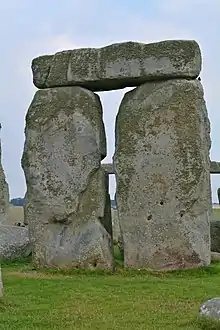trilithon
English

A trilithon at Stonehenge
Pronunciation
- IPA(key): /ˈtɹaɪ.lɪ.θɔn/
Noun
trilithon (plural trilithons or trilitha)
- A structure consisting of two stone pillars supporting a horizontal stone.
- 1846, Edward Duke, The Druidical Temples of the County of Wilts, page 158,
- […] thus the two opposite trilithons which are nearest to the north-west or grand entrance, were 19 feet in height, the two next opposite trilithons correspond in the height of 20 feet 3 inches, and the trilithon at the back of the stone of astronomic observation, or as erringly called the Altar-stone, raised its ascent to the astonishing height of 25 feet.
- 1983, Hans van der Laan, Architectonic Space: Fifteen Lessons on the Disposition of the Human Habitat, page 193,
- The two trilithons forming the wall on each side of the cella therefore pass on the mutual neighbourhood to each other, despite the fact that they are set a slight distance apart. But owing to the oblique placing of the pair of trilithons nearest the head-end the spread is greatly reduced on that side; the head-trilithon stands at the exact spot where it ceases.
- 2007, Brad Olsen, Sacred Places Europe: 108 Destinations, Consortium of Collective Consciousness, page 45,
- Within the sarsen circle are the five impressive trilithons, forming a horseshoe-shaped ring of huge stones.
- 2009, John Beer, Romanticism, Revolution and Language: The Fate of the Word from Samuel Johnson to George Eliot, Cambridge University Press, page 84,
- […] whereas the four-square gallows would have been more likely to suggest to his contemporary Blake, who normally used symbolism for its own sake, a resemblance to one of the four-square trilitha at Stonehenge.
- 1846, Edward Duke, The Druidical Temples of the County of Wilts, page 158,
Synonyms
- (two stone pillars supporting a third stone): trilith
This article is issued from Wiktionary. The text is licensed under Creative Commons - Attribution - Sharealike. Additional terms may apply for the media files.